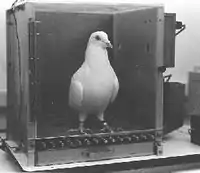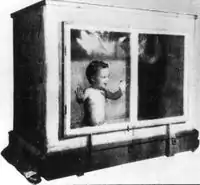Skinner box
The Skinner box[1] is a device that was first developed by B. F. Skinner in his work on operant conditioning. A subject was placed in the box, and the mechanism gave small amounts of food each time the subject performed a particular action, such as depressing a lever or pecking a disk. With the operant conditioning chamber attached to a recording device, Skinner was able to discover schedules of reinforcement. These patterns are the basis for organismic interactions with the environment and are explored extensively in Schedules of Reinforcement and elsewhere.
| Tell me about your mother Psychology |
| For our next session... |
|
| Popping into your mind |
v - t - e |

Shaping
Skinner later developed a technique called shaping through successive approximation. By rewarding more and more exaggerated behavior, complex actions could be trained through small successive rewards. For example, if a pigeon turned its head left, some food is dropped. The next time the pigeon does that he has to turn a little more left to get the food. Eventually you can train the pigeon to turn all the way around in a circle.
Backward chaining
Skinner also developed backward chaining. A complex series of behaviors can be created if taught "backwards". For example if the desired behavior was for a monkey to jump off a ledge, catch a rope, swing to a platform then climb to a banana, this could be taught sequentially. First the monkey would be placed on the platform, where it climbs to the banana. Then the monkey might be placed on the rope, where it learns it can swing to the platform, climb up and get the banana. Then it might be placed on the ledge, where it learns it can jump onto the rope. In this way behaviors can be "chained" together.
Philosophy
Skinner was a radical behaviorist—he stated that the causes of behavior, thoughts and actions stemmed from interactions with the immediate setting, and were a complex function of the past history of the organism and its genetic endowment.[2]
Radical behaviorism differed from methodological behaviorism in that it did not require consensus for truth, and so it could speculate on any behavioral process that showed regularity. Skinner, then, extrapolated his theories to emotions, thoughts, perception and other covert behaviors which are typically unobservable. Conventional behaviorism could not do this. Skinner's radical behaviorism was strongly against theories that could not be tested. His method was also data driven and inductive and showed close similarities to Ernst Mach's position on the role of hypothesis in scientific speculation.
Radical behaviorism is not the science of behavior, but is the philosophy of that science. As such it answers questions, or takes positions on them, which are not in the realm of science but must form the basis of one. For example, Skinner asserts that all behavior is governed by laws, not random or capricious, and so is capable of being the object of science. Without this assumption scientific investigation would be pointless.
Walden Two
Skinner also wrote a novel which offered a plan for a grand Utopian society. This community asked its members to work on average four hours a day. Art, music, literature, meaningful relationships, games, theater and physical activities filled the rest of the time of members.
The community was minimally consuming, anticipating current ecological sentiments by several decades. The community also asserted total equality between the sexes, and had no significant economic differences between all members.[3]
A community named Comunidad de los Horcones is based on Walden Two. Los Horcones
Criticism
The cognitive revolution of the 1960s argued against the views of behaviorism, and asserted that the black box of the mind had as much, if not more, control than environmental reinforcement.[6]
Skinner's box and superstition
Skinner's research discovered many fascinating examples of animal behavior. One of the most interesting, perhaps, was Skinner's work on superstition. Instead of giving a reward for a specific action and training a specific behavior, Skinner would take a hungry pigeon and place it in a box that would release a food pellet at random. The pigeons developed all kinds of complex behavioral responses such as bowing, scraping, dancing, and neck turns.[7]
What happened was the pigeon would receive the food pellet while it happened to be performing some action, and rather than attributing the food pellet reward to randomness, it would assume that the appearance of the food pellet had something to do with its behavior. So it started doing whatever that action was, over and over again, and sure enough, it was eventually rewarded with a food pellet again. Since the pigeon is increasing the amount of time spent performing a particular action, it is also increasing the number of times it is "rewarded" for that action, even though the reward is random.[7]
The Skinner box urban legend

One popular urban legend was that Skinner raised his daughter Deborah in one of his Skinner boxes for the first few years of her life. This is actually not true—Skinner built a "baby tender" which was a complicated crib designed to keep his daughter warm and safe. While she spent the nights in a larger version of this crib, no conditioning experiments were performed. The picture of his daughter in a smaller version of his prototype has become famous for this reason.[8]
A similar version of this was described in Skinner's Utopian novel, Walden Two; being heated, the crib was said to eliminate the need for clothing and covering for the baby (bar diapers, for the obvious reasons), and a high-tech non-absorptive sheeting was described, intended to minimize the labor necessary to handle the baby's excreta.
References
- Not the skinning chamber, which may have been used as a device for torture/capital punishment
- Skinner, B. (1976). About behaviorism. Vintage Books New York. Retrieved from
- Skinner, B. F. (2005). Walden Two. Hackett Pub Co Inc.
- Satellite photograph of Los Horcones.
- Comunidad de los Horcones. Old website: . New website: . "Isolated Desert Community Lives by Skinner's Precepts." The New York Times: Nov. 7, 1989.
- Miller, G. (2003). The cognitive revolution: a historical perspective. Trends in Cognitive Sciences, 7(3), 141. Retrieved from
- Morse, W., & Skinner, B. (1957). A Second Type of Superstition in the Pigeon. The American Journal of Psychology, 70(2), 308-311. Retrieved from
- Snopes entry on the Skinner Box by David Mikkelson (9 March 2014): "One Man and a Baby Box"